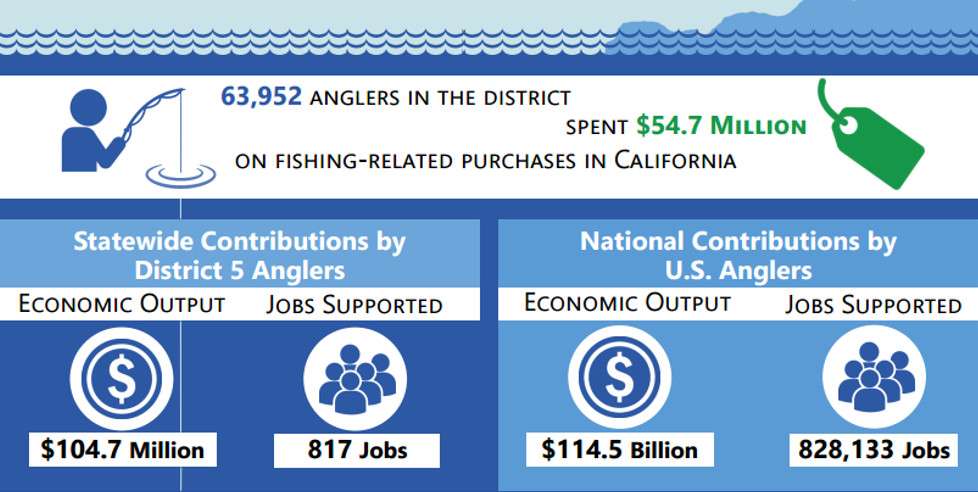
ALEXANDRIA, Va. — As anglers, we know that the real value of recreational fishing is incalculable simply because it is a wholesome, family-friendly activity enjoyed by an estimated 46 million Americans annually, with great social, historic and cultural significance.
Too often, though, that importance gets lost in the noise of politics, as state and federal legislators look to economics to decide policies that can have a profound impact on the future of individual fisheries, as well as fishing in general. That’s why what the American Sportfishing Association (ASA) and Southwick Associates have assembled is so noteworthy.
Using a series of one-page infographics, “Economic Contributions of Recreational Fishing: U.S. Congressional Districts” provides unprecedented and detailed insight into the value of recreational fishing that decision-makers should understand. You can find your district breakdown here.
“Fishing is more than a hobby. It’s an economic engine,” said Gene Gilliland, B.A.S.S. national conservation director. “This is powerful information that we can use to protect our fishery resources and access to them.”
“Members of Congress consistently identify jobs and economic opportunity among their top priorities,” said Scott Gudes, ASA vice president for government affairs.” Clearly, recreational fishing is a tremendous economic driver and job creator. These pictorial reports deliver that point very succinctly by depicting for members of Congress the economic impacts of recreational fishing in the district or state they represent.”
Nationally, anglers generate more than $48 billion in retail sales with a $115 billion impact on the economy, creating employment for more than 800,000 people.
“Recreational fishing is the foundation of an industry that involves not just the manufacturing, sale or provision of tackle and other fishing gear, but also includes services such as tackle retailers, boat builders, hotels, restaurants and much more,” ASA said.
And not surprisingly, recreational fishing contributes most to the state economies of California, Florida, Texas and New York. These days, though, many West Coast anglers will tell you that they are fearful for the future of their sport. Since 1980, license sales have dropped nearly 55 percent, despite a significant population increase, as the cost of a fishing license has skyrocketed from $5 to $47.
“California’s recreational anglers have become increasingly frustrated with the state for increasing the cost of fishing, all the while imposing greater barriers to access and constantly adding new and burdensome regulations,” said the California Sportfishing League.
More recently, California’s senators, Barbara Boxer and Diane Feinstein, have pushed for legislation that would decimate the California Delta’s world-class bass fishery as part of an ill-conceived strategy to save salmon and allocate water.
Can the revelation that recreational fishing has a multiplier value of $4,415,769,782 annually for California, with related salaries and wages of $1,515,607,795 help counter the assault on recreational fishing in that state?
Or in Florida, where federal bureaucrats want to prohibit fishing in a large area of Biscayne National Park? Multiplier value in the Sunshine State is $7,017,635,755, with related salaries and wages of $2,157,717,353, as well as $4,055,209,152 in retail sales.
Yet, in recently creating the Keep Florida Fishing website, ASA warned, “The list of initiatives to ban or severely restrict recreational fishing and boating access in Florida is growing every day. Over the past decade, the misguided attempts to manage fisheries include Biscayne National Park, the Everglades, the Florida Keys National Marine Sanctuary, and red snapper on both coasts.”
Both Gilliland and Gudes are hopeful that this report will educate politicians regarding the economic importance of fishing and possibly help ensure its future.
“These reports will help ASA and our partners to raise awareness among members of Congress about the importance of recreational fishing in their state or district. Given the increasing number of legislative and policy issues confronting the recreational fishing community, it’s critical that we provide accurate, detailed information to decision-makers on the tremendous value that recreational fishing provides to the nation,” Gudes said.
Gilliland added that the report provides “exactly the kind of ammunition anglers need when they are engaged in discussions with lawmakers about the value of water.
“Whether a lake, river, or reservoir provides drinking water, flood control, hydropower, irrigation, or any number of other competing uses, recreational fishing can hold its own and, in many cases, is actually worth more than those other uses.”
See what information the report provides for your state by going to this link and clicking on the initial letter of your state.





